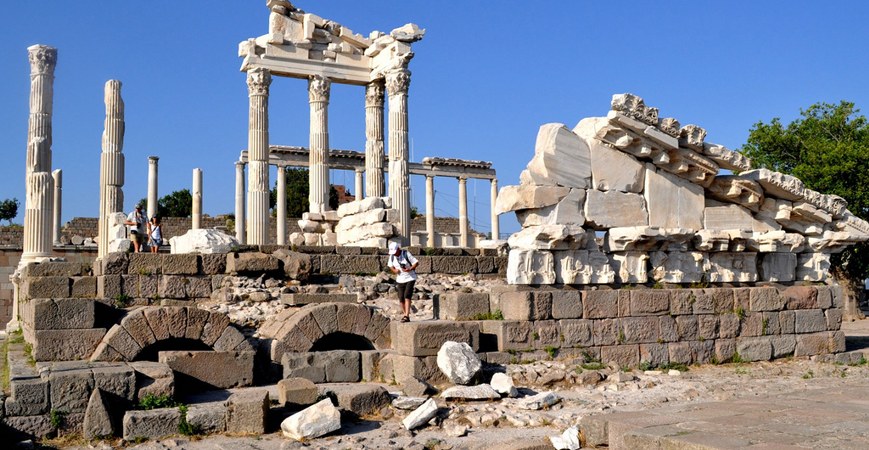Pergamon
Pergamon, one of the most important cities of the Mysia region, has spread out to the ovary starting from the skirts of the hill where the acropolis is located. The land that flows from the two sides of the hill where the acropolis is located and increases the productivity of the Selinos and Kestel (Çeitos) streams to the Bakırçay River (Kalkos) has been one of the favorite cities of the Ancient Times. The city that the Bergama Stream (Selinos) divides into two, is stretched up to the place called “Musalla Cemetery” in the plains around the tea with the natural resources. It is 392.3 m. The height of the steep slopes of the city from the sea because of the immigration was not affected. However, the close proximity to Pitane (Çandarlı) and Dikili Bay led to the connection with the King’s Road by way of reaching Akhisar (Thyateria) which follows the Kaiko Valley in the west, which made the city important.
Remains, pottery and tools found in the researches made in Bergama have shown that the settlement in the region started in the Neolithic Age. Among the land fillings in the skirts of the acropolis there were stone knives dated to this turn, and an ax of nephrite stone was found in the hovering hill. These works, dating to 4000 BC, were followed by pottery from the Bronze Age. A small settlement in the Archaic period, but few remnants of this period, showed that Pergamon finds a settlement in the Acropolis in 8000 BC.
Temple of Trajan
The remains of a great building appeared in the acropolis in 1883-1885, and many architectural fragments around it revealed that this structure was destroyed after an earthquake. Nine at the Athena Temple, 55 m from the theater terrace. It was understood that the building at the height was connected to the Athena temple and the door and the stairs to the east were also in the library. The terrace where this structure is located is the highest point of the acropolis. Previously there was a hellish period structure, the area was reinforced with arches and vaults, and the surroundings were surrounded by stones. The temple of Traianus (M.S.98-117), the emperor of the Romans, was recognized here. The temple was completed during the reign of the Emperor Hadrianus (M.S.117-138). During the excavations, two statues of both emperors were found today at the Berlin Museum.
Temple of Dionysus
The temple of Dionysus, built in the 3rd century BC on the northern end of the theater terrace, was rebuilt by the Roman Emperor Carcalla (M.S.211-217). In its first construction, the temple, which is made of andesite, was entirely covered with marble in the Roman period, and it was added to the prostylus structure in the Ion style with twenty-five steps. Today the temple of Dionysus, which is preserved very well together with the master, is a Prostylos in the Ion style on a high podium. The head of the Astlepios in these excavations is at the Pergamon Museum in Berlin.
Zeus Amateur
King of Pergamon II. King of Seleucus III of Eumenes (1979-MS.159) To commemorate the victory against Antiochos and Galatas, Athena was built to the south of the temple and to the center of the site 25 meters further down. The entrance of the altar is in the west direction and is built in two layers on a five-step crepedidoma.
The inside of the lower floor of the building which has a plan in the shape of a horse is a saucer. The outer face of this section is decorated with reliefs embellishing the victory of the Olympus gods against the gigants. These embossments surrounding the pavilion are 120 meters long and 2.30 meters high.
The upper floor is surrounded by Ionic stao. This section comes from the stairs on the west side, where the victim’s table is located. The sacrificial table is again surrounded by walls in the plan of the horse. There are ionic flat galleys on the inside and outside of the wall, and the galleries inside are not completed. The victims were cut down and burned on top of the window. Only the men could enter the upper division where the flesh was burned.
Today, only the basic remains of this present at the Pergamon Museum in Berlin are in Bergama.
Pergamon Antique City Asklepion Health Center
Asklepion, 1 km south west of the city. A street with a column in the length and an obscure ceremony where the Romans gave the name Via Tecta To Bergama.














